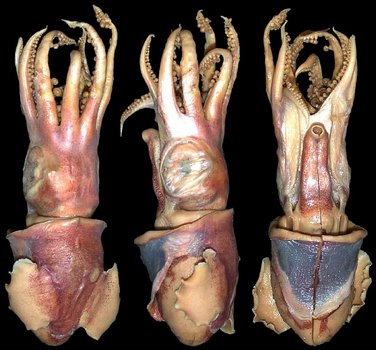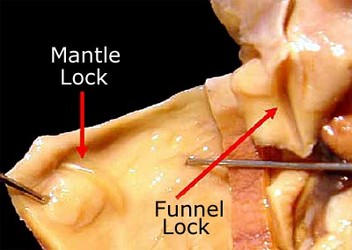Choneteuthis tongaensis
Chung Cheng Lu and Richard E. YoungIntroduction
Choneteuthis tongaensis is known from 3 specimens, the largest of which is 33.8 mm ML (holotype), that were taken in the vicinity of the Tonga Islands, South Pacific Ocean. The holotype is a female missing tentacles as is the second paratype. The first paratype is a male known from only the head and brachial crown.
Brief diagnosis:
A sepiolid with ...
- mantle free from head in nuchal region.
- large, circular visceral photophore and ventral shield.
- broad keel extending full length of club.
Characteristics
- Arms
- Suckers in two series to tips on all arms.
- Males
- Suckers on arms I and IV decrease in size from arm base to arm tip.
- Suckers in dorsal series of arms II increase in size to mid-arm then decrease to arm tip; suckers in ventral series increase in size to mid-arm followed by 3 or 4 abruptly enlarged enormous, somewhat flattened suckers then decrease in size to tip.
- Suckers in dorsal series of arms III increase in size from arm base for 3 or 4 suckers followed by 2 or 3 abruptly enlarged suckers to mid-arm then decrease in size to arm tip; suckers in ventral series decrease in size to tip.
- Females
- Suckers increase in size from arm base to mid-arm then decrease in size to arm tip.
- No sucker enlargement.
- Suckers in two series to tips on all arms.
- Web
- Web (sector A) between arms I shallow (10% of longest arm in male; 14% in female).
- Web (sector A) between arms I shallow (10% of longest arm in male; 14% in female).
- Tentacles
- Club (known only for male, paratype 1) slightly expanded with suckers in about 6 series.
- Keel lies close to dorsal protective membrane from club tip to just beyond carpal region; widest along club manus.
- Club (known only for male, paratype 1) slightly expanded with suckers in about 6 series.
- Head
- Nuchal cartilage present, cartilagenous, broader anteriorly with matching mantle cartilage.
- Head not fused to mantle in nuchal region.
- Nuchal cartilage present, cartilagenous, broader anteriorly with matching mantle cartilage.
- Funnel
- Funnel long, tubular; length over 60% of ML, free from head for 75% of its length.
- Funnel long, tubular; length over 60% of ML, free from head for 75% of its length.
- Funnel/mantle locking-apparatus
- Mantle component a simple, curved, raised ridge.
- Funnel component shoe-shaped with wider anterior end and curved depression.
- Mantle component a simple, curved, raised ridge.
- Mantle
- Ventral mantle not extending anteriorly beneath head.
- Ventral mantle not extending anteriorly beneath head.
- Photophores
- Single, large round photophore on ventral surface of ink sac.
- Single, large round photophore on ventral surface of ink sac.
Comments
More details of the description of C. tongaensis can be seen here.
The above description with the exception of a few photographs is taken from Lu and Boucher-Rodoni (2006).
Distribution
Type locality: The holotype (MNHN 3820) came from the Tonga Islands, N Ha’apai group, 19°42’S, 174°26’W, depth 332m. Paratype 1, male (head only), came from this same station. Paratype 2 (MNHN 3822) came from a seamount in the Tonga Islands at 22°11’S, 175°27’W, depth 385–405m.
References
Lu, C. C. and R. Boucher-Rodoni. 2006. A new genus and species of sepiolid squid from the waters around Tonga in the central South Pacific (Mollusca: Cephalopoda: Sepiolidae). Zootaxa, 1310:37-51.
Title Illustrations

About This Page

National Chung Hsing University Taiwan

University of Hawaii, Honolulu, HI, USA
Page copyright © 2019 and
All Rights Reserved.
- First online 18 December 2006
- Content changed 26 December 2007
Citing this page:
Lu, Chung Cheng and Richard E. Young. 2007. Choneteuthis tongaensis . Version 26 December 2007 (under construction). http://tolweb.org/Choneteuthis_tongaensis/91865/2007.12.26 in The Tree of Life Web Project, http://tolweb.org/













 Go to quick links
Go to quick search
Go to navigation for this section of the ToL site
Go to detailed links for the ToL site
Go to quick links
Go to quick search
Go to navigation for this section of the ToL site
Go to detailed links for the ToL site